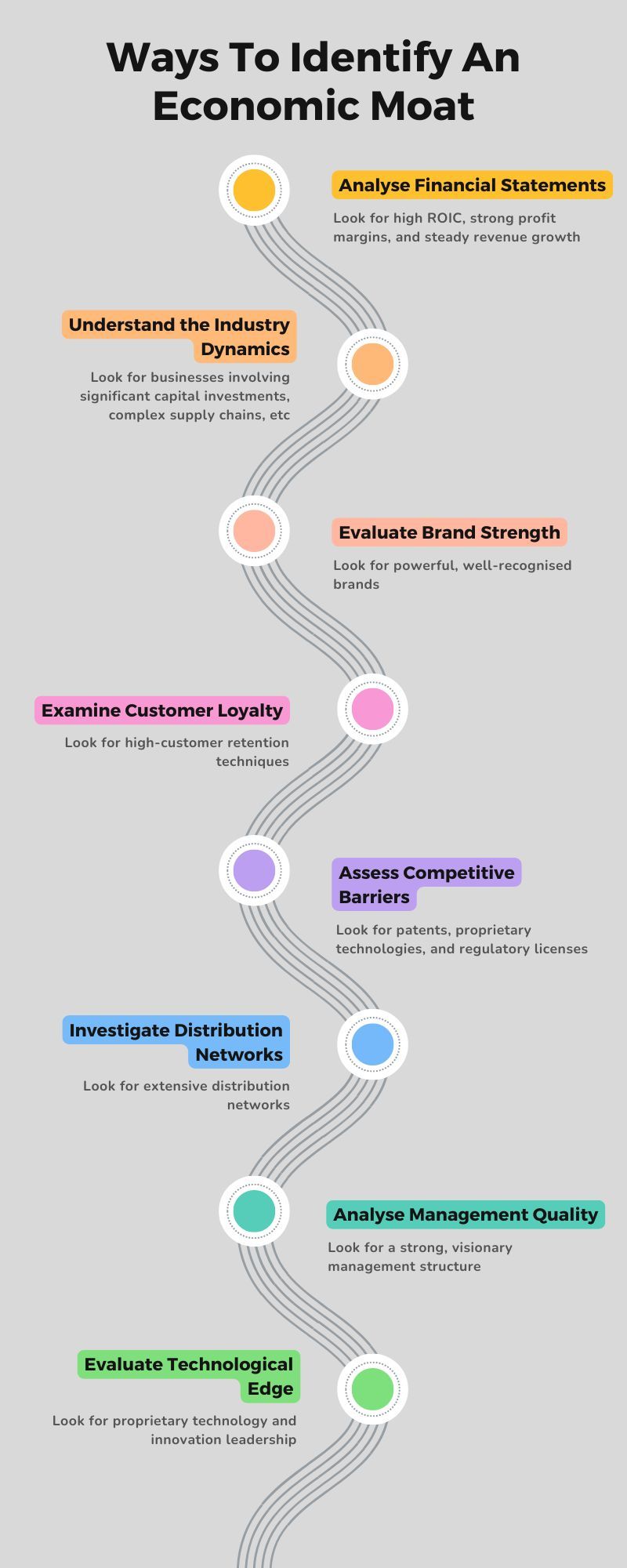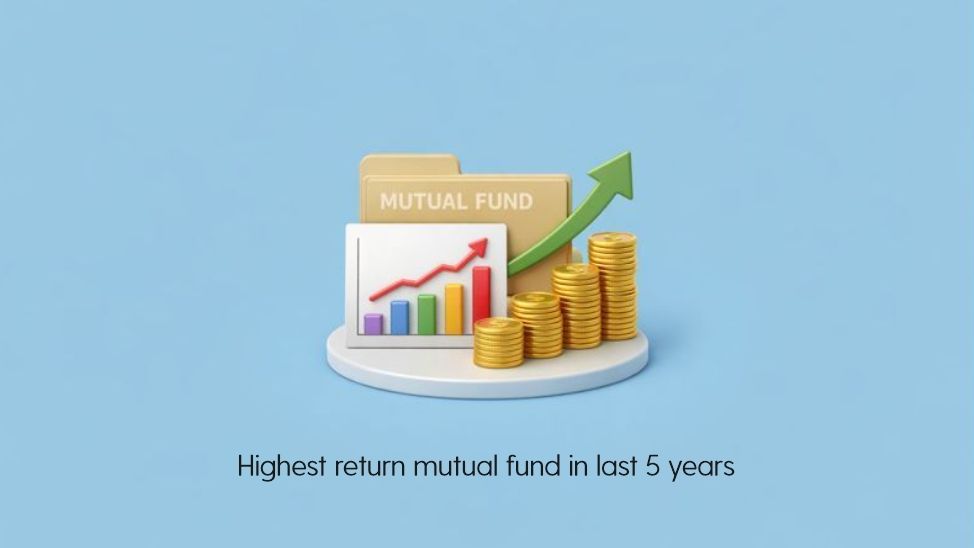- Home
- Blog
- Demat Account
- Moat Full Form
- Moat Full Form
Moat Full Form

- Published Date: September 09, 2024
- Updated Date: June 17, 2025
- By Team Choice
In the competitive business landscape, many companies and organisations actively strive to be ahead of their competitors by securing a position that sets them apart. “Moat” - is one of the key concepts that help businesses maintain their competitive edge.
This term originally means a deep, wide trench filled with water surrounding a castle. However, in the business world, the term depicts something equally powerful - a strong, enduring competitive advantage.
This article will explore the meaning of Moat in detail to help you gain insights into how certain businesses can consistently outperform their competitors while protecting their market positions.
What is An Economic Moat?
An “economic moat” is a popular term that describes a company’s ability to maintain a competitive edge against its rivals. The aim is to protect and secure the company’s long-term profits and market share. This term was first made popular by Warren Buffett, who conveyed that moats are a type of competitive advantage that is more durable than others. To simplify, similar to how actual moats shield the castle from invaders, economic moats protect businesses from their competitors.
Important Things to Know About Economic Moats
Recognising certain key factors contributing to a company’s ability to sustain its market position can help you understand economic moats better:
- Durability: An economic moat must be sustainable over the long run. Temporary advantages, such as short-lived cost-reduction or fleeting market trends, do not constitute a true moat. A moat should provide a lasting competitive advantage that can withstand market volatility and pressure from competitors.
- Competitor Barriers: An essential feature of a strong economic moat is the presence of significant barriers that prevent competitors from easily entering the market or mirroring the company’s success. The barriers may involve intellectual property, high capital requirements, or regulatory approvals.
- Profitability: Companies with strong economic moat usually enjoy high profitability. It happens because they charge premium prices, and maintain lower costs due to operational efficiency or both. Achieving and sustaining high profit margins is a key indicator of a strong moat.
- Market Position: Companies with strong economic moat typically have a dominant position in their industry. This strong market presence often translates into greater influence over pricing, supply chains, market trends, etc. allowing the company to maintain its competitive edge.
Watch the following video to get a clear picture of what exactly is an economic moat and why it is significant for a company’s long-term success.
Different Ways To Create An Economic Moat
Let’s discuss some of how a robust economic moat can be created:
1. Cost Advantage:
One of the most effective ways to build a moat is a cost advantage. Companies that can produce goods or services at a lower cost than their competitors have a significant edge. This advantage can stem from various factors, including:
- Economies of Scale: Large companies can produce goods in bulk, which often leads to lower per-unit costs. This cost reduction can be due to more efficient use of resources, better negotiation power with suppliers, or advanced technology that reduces production expenses.
- Operational Efficiency: Companies that streamline operations, reduce waste, and optimise the supply chain can significantly lower costs. This efficiency allows them to offer competitive pricing while maintaining healthy profit margins.
- Access to Cheaper Resources: Companies that secure favourable terms with suppliers, own their production facilities, or have exclusive access to low-cost raw materials can reduce their costs and undercut competitors.
By maintaining a cost advantage, companies can either offer lower prices to attract price-sensitive customers or retain higher margins, reinvesting those profits into further growth or innovation.
2. Size Advantage:
Size advantage, often referred to as economies of scale that we discussed in the previous point, plays a critical role in creating an economic moat. Large companies benefit from their scale in several ways:
- Lower Per-Unit Costs: As companies grow, they can spread fixed costs, such as research and development or marketing expenses, over a large number of units. This reduces the cost per unit, giving the company a pricing advantage over smaller competitors.
- Greater Bargaining Power: Large companies can exert more influence over their suppliers and customers. They can negotiate better terms, such as bulk discounts or favourable payment terms, which further reduces their costs and increases profitability.
- Network Effects: In industries where network effects are strong, the value of a product or service increases as more people use it. For example, social media platforms or payment processing systems become more valuable as more users join. This creates a self-reinforcing cycle where the largest players become increasingly dominant.
Size advantage acts as a barrier to entry, as smaller competitors find it difficult to match the efficiency, pricing power, and market reach of larger, established firms.
3. High Switching Cost:
High switching costs create a formidable barrier that locks customers into a company’s ecosystem. When customers face significant costs, inconvenience, or risk in switching to a competitor’s product, they are more likely to stay with the original company. Here’s how switching costs contribute to an economic moat:
- Financials Costs: If switching to a competitor involves high upfront costs, such as new equipment, installation fees, or contractual penalties, customers are less likely to make the switch.
- Learning Curve: Products or services that require significant time or effort to learn, such as complex software systems or specialised machinery, create a dependency. Customers may be reluctant to switch to a competitor if it means retaining staff or disrupting their operations.
- Compatibility Issues: In some industries, products are designed to work within a specific ecosystem. For example, a company may offer a suite of software products that are highly integrated. Switching to a competitor may mean losing this integration, which could disrupt the customer’s operations.
High switching costs not only foster customer loyalty but also deter competitors from attempting to lure customers away, knowing that the effort and cost required to convince them to switch are substantial.
4. Intangibles:
Intangible assets are non-physical that can significantly contribute to a company’s economic moat. These include:
- Brand Strength: A strong brand can command premium prices, attract loyal customers, and create a perception of quality or prestige. Brands like Apple or Nike have built such strong identities that customers are willing to pay more for their products, despite the availability of cheaper alternatives.
- Patents and Proprietary Technology: Companies that hold patents have exclusive rights to produce and sell their innovations, giving them a legal monopoly for a set period. This prevents competitors from copying their products and allows them to maintain high-profit margins.
- Exclusive Contracts: Companies that secure long-term contracts with key customers or suppliers can create a stable revenue stream that is difficult for competitors to disrupt.
Intangibles like brand strength and intellectual property create a durable competitive advantage, as they are often challenging for competitors to replicate or overcome.
5. Soft Moats:
Soft moats refer to less tangible factors that can still provide a strong competitive advantage. While harder to quantify, these moats are often rooted in the company’s culture, reputation, or customer relationships:
- Corporate Culture: A company with a strong, positive corporate culture can attract and retain top talents, foster innovation, and maintain high levels of employee engagement. This culture can be a powerful differentiator, especially in industries where creativity and innovation are key to success.
- Customer Trust: Companies that have built a reputation for reliability, quality, and ethical practices often enjoy high levels of customer trust. This trust can translate into customer loyalty, repeat business, and positive word of mouth, which are difficult for customers to undermine.
- Corporate Social Responsibility (CSR): Companies that are seen as socially responsible or environmentally conscious can differentiate themselves from competitors. This can attract customers who prioritise ethical considerations in their purchasing decisions, creating a loyal base that values the company’s principles as much as its products.
Soft moats may not be as immediately visible as cost advantages or patents, but they can be equally powerful in maintaining a company’s competitive position over time.
Example of an Economic Moat
Imagine you’re running a small bakery and decide to leverage a cost advantage to boost your business. Initially, you find that by purchasing flour and sugar in bulk, you can significantly cut your ingredient costs, enabling you to offer lower prices for your baked goods compared to your competitors. This pricing strategy quickly attracts a large number of customers, leading to a surge in your profits.
However, it’s likely that other local bakeries will soon notice your success and start buying ingredients in bulk as well, thus replacing your cost-saving method. As a result, the competitive landscape evens out, and your initial profit advantage diminishes over time.
Now, suppose instead of merely focusing on bulk purchasing, you invest in adopting a unique energy-efficient baking oven that reduces your energy cost by 30%. You patent this oven, making it a proprietary technology that no one else can use without your permission. This patented technology allows you to continue reducing your costs and offering lower prices, maintaining a competitive edge that others cannot easily replicate.
In such a scenario, the economic moat for your business is showcased by the patent on your innovative baking oven. This moat protects your competitive advantage, enabling you to sustain your market leadership and profitability over a longer period. Unlike the cost advantage from bulk buying, which competitors can quickly match, your patented technology creates a more durable barrier against competition, ensuring that your business remains profitable and robust in the long run.
How to Identify an Economic Moat
Identifying an economic moat involves thoroughly examining various factors contributing to a company’s sustained competitive advantage. Here are some key methods to spot a moat:

1. Analyse Financial Statements:
Look for companies with consistently high returns on invested capital (ROIC) and strong profit margins, which indicate efficient profit generation and competitive strength. Steady revenue growth and robust cash flow are also signs of a resilient business model with a durable moat.
2. Understand the Industry:
Certain industries are more conducive to economic moats, especially those with high entry barriers like regulatory requirements, significant capital investments, or complex supply chains. Industries such as pharmaceuticals, utilities, and telecommunications often support companies with strong moats due to these inherent challenges for new entrants.
3. Evaluate Brand Strength:
In the stock market, companies with powerful, well-recognised brands often command higher valuations. A strong brand can allow a company to change premium prices and maintain customer loyalty, contributing to sustained profitability and a competitive edge.
4. Examine Customer Loyalty:
Companies with high customer retention rates often have a strong moat. High switching costs, unique product offerings, or exceptional customer service make it difficult for competitors to lure customers away, which supports consistent revenue and stable stock performance.
5. Assess Competitive Barriers:
Identify companies that hold patents, proprietary technologies, or regulatory licenses that protect their market position. These barriers can prevent competitors from easily replicating the company’s success, contributing to long-term stability and stock price appreciation.
6. Investigate Distribution Networks:
Companies with extensive and efficient distribution networks often have a competitive advantage. In the stock market, such companies exhibit stable or growing market shares, reflecting their ability to reach a wide customer base and maintain dominance.
7. Analyse Management Quality:
Strong, visionary management teams can build and maintain economic moats through strategic innovation, effective capital allocation, and navigating market challenges. Companies with proven leadership often enjoy sustained growth, which can be reflected in their stock performance.
8. Evaluate Technological Edge:
In the stock market, companies that lead in technological advancements often have a significant moat. Proprietary technology or innovation can set a company apart from its competitors, driving long-term growth and making it an attractive investment.
Final Words
Understanding the term ‘Moat’ in the context of the stock market helps to analyse the critical role it plays in safeguarding a company’s long-term success. A strong economic moat allows a business to experience a sustainable competitive advantage, allowing it to fend off competitors and maintain profitability over time.
However, it’s important to note that analysing the economic moat of a company is just one step in a thorough investment strategy. As an investor, it is equally important to consider other important factors such as tools for financial statement analysis, management efficiency, and market position to evaluate a company’s potential for sustainable growth. This is where fundamental analysis comes into play, offering ways to assess a company’s strengths and weaknesses.
If you're interested in learning more about how to comprehensively evaluate stocks, including how economic moats fit into broader investment strategies, we invite you to explore our "Fundamental Analysis of Stocks - Meaning, Types & How to Use" blog. This resource will provide you with valuable insights on how to assess a company's true value and growth potential, complementing your understanding of economic moats.
Recommended for you

FII DII Data - Live Data

Share Market Prediction For Tomorrow

Market Prediction Today (1th December 2025)
